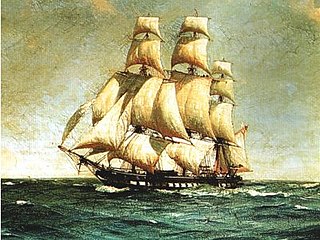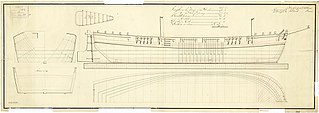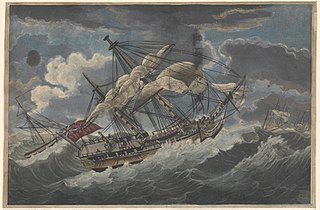Career
Lieutenant James Ryder commissioned Griper in May 1797. In May 1798 Lieutenant Malcolm Cowan replaced Ryder. She underwent coppering at Portsmouth in June. Lieutenant Edward Hodge commanded Griper in 1799. On 19 August Griper arrived in Sunderland. She had been on a "private expedition" when she had lost her topmasts. She left the fleet off the Texel a week or so earlier. She had rigged jury-masts and Sunderland was the first port she could reach. She had 19 soldiers aboard; al were well. [2]
Lieutenant Mathew Graham commanded Griper in 1800. Lieutenant Henry Fyge Jauncey commanded Griper in the Baltic in 1801. On 14 April Griper was at Sheerness. A midshipman, her surgeon, a pilot, a marine, and five seamen were in it sailing from Griper into the Nore when a gale overturned the boat. The midshipman and three seamen drowned. [3] On 21 April Griper sailed for the Baltic in company with a number of other brigs and larger warships. She returned to Yarmouth on 21 July. In August she cruised off the coast of France. In April 1802 orders came that Griper was to be paid off.

HMS Ardent was a 64–gun third-rate ship of the line of the Royal Navy, launched on 9 April 1796 at Northfleet. She had been designed and laid down for the British East India Company who was going to name her Princess Royal, but the Navy purchased her before launching, for service as a warship in the French Revolutionary War.
Launched on 21 May 1797, GB No. 21 was renamed HMS Defender on 7 August the same year. She was a 12-gun Courser-class gun-brig built for the British Royal Navy at Limehouse and disposed of in 1802.

HMS Investigator was the mercantile Fram, launched in 1795, which the Royal Navy purchased in 1798 and renamed HMS Xenophon, and then in 1801 converted to a survey ship under the name HMS Investigator. In 1802, under the command of Matthew Flinders, she was the first ship to circumnavigate Australia. The Navy sold her in 1810 and she returned to mercantile service under the name Xenophon. She was probably broken up c.1872.

Sensible was a 32-gun Magicienne-class frigate of the French Navy. The Royal Navy captured her in 1798 off Malta and took into service as HMS Sensible. She was lost in a grounding off Ceylon in 1802.

Skeffington Lutwidge was an officer of the Royal Navy, who saw service during the American War of Independence, and the French Revolutionary and Napoleonic Wars. He had a particular connection with Horatio Nelson, who served under Lutwidge as a midshipman on an expedition to the Arctic in HMS Carcass in 1773, and again in 1801 while a captain, when Lutwidge was commander in chief in the Downs. Lutwidge served for a considerable period and in a number of ships, in American waters during the War of Independence. During this time he captured a number of American privateers, and was involved in operations on Lake Champlain. He reached flag rank soon after the start of the French Revolutionary Wars, and served mainly in Home waters as commander in chief of some of the stations on the south coast. He retired from active service with the rank of admiral, and died in 1814, shortly before the end of the Napoleonic Wars. He was the great-uncle of Lewis Carroll.
HMS Crash was a 12-gun Acute-class gun-brig. She was launched in April 1797 as GB No. 15 and received the name Crash in August. She served against the French and Dutch in the Napoleonic Wars, though after her capture in 1798 she spent a year in the service of the Batavian republic before the British recaptured her. She was sold in 1802.
HMS Alcmene was a 32-gun Alcmene-class fifth rate of the Royal Navy. This frigate served during the French Revolutionary and Napoleonic Wars under the command of several notable officers. Alcmene was active in several theatres of the war, spending most of her time cruising in search of enemy vessels or privateers, and escorting convoys. She fought at the Battle of Copenhagen in 1801 and served in the blockade of the French coasts during the later Napoleonic Wars until she was wrecked on the French coast in 1809.

L'Espoir was a French brig-sloop that served for 9½ years in the French Navy before HMS Thalia captured her in September 1797. In her subsequent short career in British service as HMS Espoir she captured three prizes, with the capture in 1798 of the more heavily armed Genoese pirate Liguria earning her crew a clasp to the Naval General Service Medal. Espoir was laid up in 1799 and sold in 1804.

Gracieuse was a 32-gun Charmante-class frigate of the French Navy. Renamed to Unité in 1793, she took part in the French Revolutionary Wars. The Royal Navy captured her in 1796 off Île d'Yeu and brought her into British service as HMS Unite. She was sold in 1802

HMS Firm was a 16-gun Firm-class floating battery of the Royal Navy, launched in 1794. The two-vessel class was intended to operate in shallow waters. After the Peace of Amiens Firm was paid off in March 1802; she was sold in 1803.

HMS Calypso was a Royal Navy Echo Class ship-sloop. She was built at Deptford between 1781 and 1783, launched on 27 September 1783 and first commissioned on 1 December 1783 for service off Northern Ireland and Scotland. She served in the North Sea, Atlantic, and the West Indies. Calypso was sunk whilst acting as a convoy escort on 30 July 1803 after colliding with a West Indiaman merchant ship during a violent storm.
Prince William was built in Newcastle in 1788. She then traded between England and the Baltic. The Royal Navy first hired her in 1797. His Majesty's hired armed ship Prince William served on two contracts, one during the French Revolutionary Wars and one during the Napoleonic Wars. The Admiralty returned her to her owners at the end of each contract.

HMS Vesuve was the French brick-cannonièreVésuve, name vessel of her class of seven bricks-cannonière. She was launched at Saint-Malo in 1793. The British Royal Navy captured her in 1795 and took her into service as HMS Vesuve. The Navy sold her in 1802.
Quatre frères was either American or Bermudian built vessel and commissioned in 1796 at Bordeaux as a French privateer. The Royal Navy captured her in April 1797 and took her into service as HMS Transfer. The Royal Navy sold her at Malta in 1802 to Ottoman Tripolitania. The U.S. Navy captured her in 1804 and took her into service as USS Scourge. The U.S. Navy sold her in 1812.
HMS Pilote was a cutter launched for the French Navy at Dunkirk in 1778. The British Royal Navy captured her in 1779 and took her into service under her existing name. It sold her in 1799.

HMS Albacore was launched in 1793 at Rotherhithe. She captured several privateers before she was sold in 1802.
HMS Ferret was a Dutch hoy of the same name that the Admiralty purchased in 1794 for use as a gun-boat. It sold her in May 1802.
HMS Attack was launched in 1794 as a Conquest-class gunvessel for the Royal Navy. She had an uneventful career and the Navy sold her in 1802.
HMS Tigress was a Courser-class gun-brig built for the British Royal Navy at King's Lynn, and laid down in 1797 as GB No. 45; she was renamed Tigress on 7 August the same year. She was sold on 20 January 1802.
HMS Cracker was an Acute-class gunbrig, launched in 1797. She was sold in 1802.
This page is based on this
Wikipedia article Text is available under the
CC BY-SA 4.0 license; additional terms may apply.
Images, videos and audio are available under their respective licenses.









